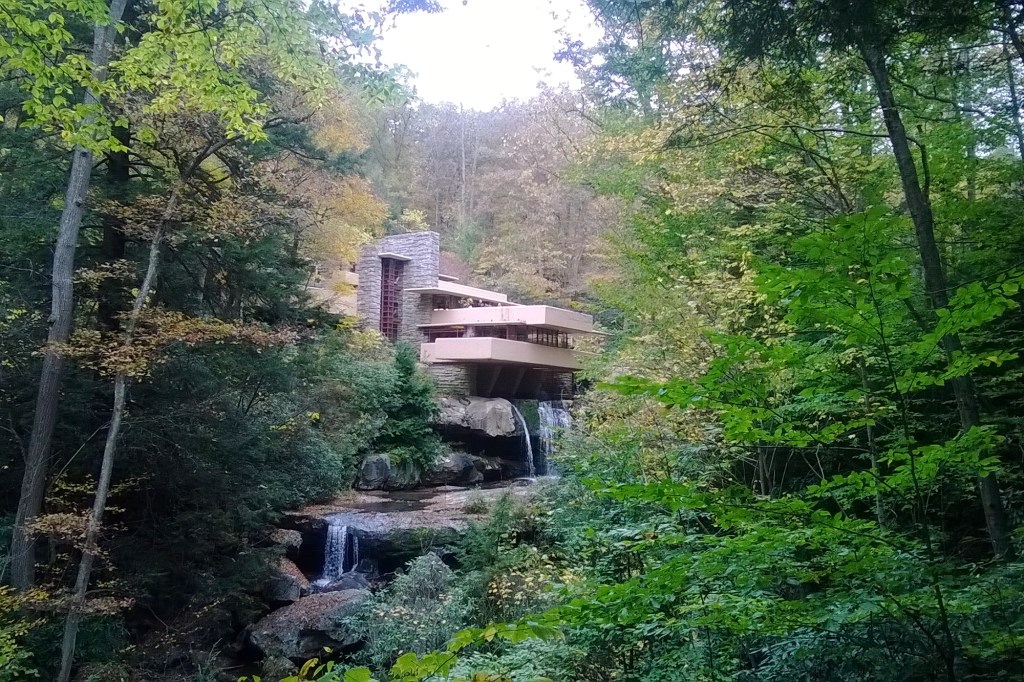“Can we go to Fallingwater?”
I somewhat fearfully asked this of my host at Carnegie Mellon University, the indomitable CMU adjunct professor Spike Wolff, when she asked me whether I wanted to do anything in Pittsburgh after my lecture there. “Any chance to go, I’ll take!” she answered immediately.
I was surprised, but equally delighted. I had not seen Fallingwater, the weekend house Frank Lloyd Wright designed for the Kaufmann family in Bear Run, Pa., since I was in college. I wondered whether it would hold up. Yes, the amount of publicity it has received indicates that it is a masterpiece, and one that continues to draw more than 100,000 visitors a year to its remote location. Yes, it is of signal importance in modern architecture, embodying as it does an alternative to the reductive forms of MoMA’s International Style exhibition—held three years before the house was designed (in 1935, and construction finished in 1937)—which turned into the dominant domestic variant of Modernism. But would the house hold up now that I have seen so many of Wright’s other structures?
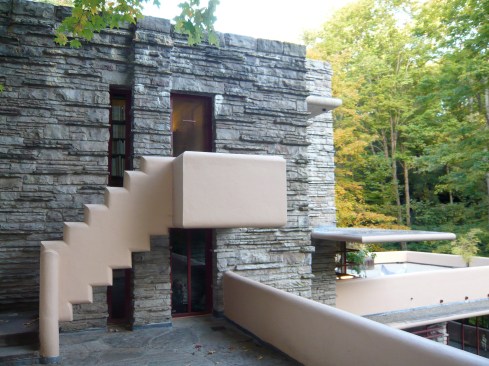
It did. Moreover, what struck me on this visit is what a beautiful piece of knitting it is.
Fallingwater (which is maintained impeccably by its owner, the Western Pennsylvania Conservancy) is, of course, knit into its landscape, tying into a small waterfall that tumbles down limestone ledges. It weaves its own cantilevers and walls, covered with the same stone as well as a yellowish plaster, out of that intersection of vertical and horizontal planes nature created in this wooded site. The weft of the walls and the weave of the red-painted metal and glass grid tie the whole structure together, creating a pattern that obviously has depth, but that does not so much contrast solid and void as it does elaborate their interpenetration. Inside, the spaces of the house continue that rhythm of planes and lines pushing through each other, sending threads out to hook the next space you encounter into the whole. Even in the details, I noticed this time around, the act of weaving continues, with bookcases hooking into walls, and lines of wood winding their way through walls and soffits.

I realized that for all of Wright’s insistence on what he called “organic” architecture unfolding from inner logic and necessity, the evidence or mode of appearance for this “truth” is a particular form of textile architecture. I should have thought of this sooner, of course, since the best way to illustrate his notions of organic architecture are by showing the textiles he designed and oversaw, from the theater curtain at Taliesin to the many woven patterns for bedspreads, curtains, and rugs that use “nature patterns” such as flowers, leaves, and trees abstracted into interwoven geometries.
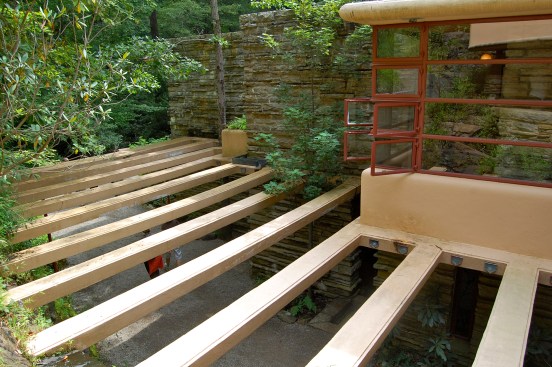
The effect of this textural approach is to break down hierarchies. At Fallingwater, there is a center and there are wings, but there is no sense of a middle and side pavilions, or spaces that are more important and less important. Rooms are larger or smaller, but they flow into each other, developing focal points rather than centers. The same is true at the level of structural details: While the hard work it took to create all those cantilevers remains hidden, what you see are columns that appear more like light posts and vertical anchors that show themselves as human-made versions of the ledges.
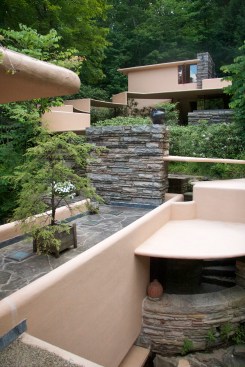
Fallingwater also famously weaves together inside and outside, as Wright invited a rock to inhabit the area in front of the living room fireplace and designed the corner windows to open up at their outside edges so that, when the panes are extended out, interior and exterior flow into each other. That complex relationship between what we think of as nature and what humans have fashioned (concrete, steel, finished wood, plaster, cut stone) makes it difficult to tell them apart—or it at least highlights the way the latter is made out of the former.
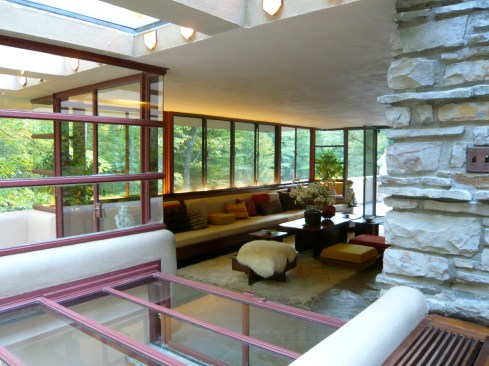
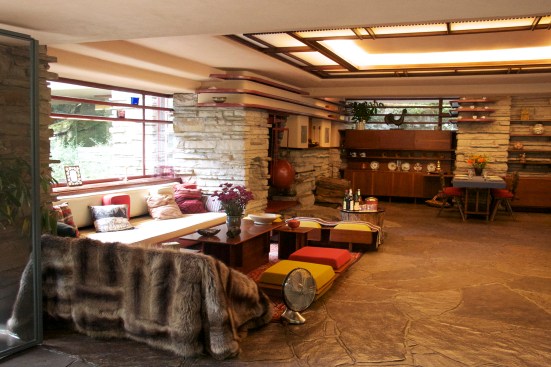
The roots of Fallingwater are, in other words, not just in nature and Wright’s idea of what that concept means, but also in an aesthetic tradition that today we know as the Arts & Crafts movement. Based on the thoughts of John Ruskin and others, the 19th-century movement propounded a weaving out of nature of not only of human forms but also of human communities. Ruskin and his followers saw their work as a recrafting, in the most literal sense of the word, of society; communities would become based on the continual making and remaking of the spaces, objects, and images of everyday use. Out of these beliefs came varied ways of making things, ranging from William Morris’ wallpaper to C.R. Ashbee’s neo-primitive furniture. Just as important, the movement spread through a hybrid of the artist’s atelier and the production factory: the Arts & Crafts community, in which craftspeople and artists collaborated and often lived together. Although the fellowship that Wright established at Taliesin in 1932 (and whose successor, the School of Architecture at Taliesin, I now guide) was a particular and different variant on this model, it was without a doubt inspired by communities such as Ashbee’s Guild and School of Handicraft, which Wright visited several times.
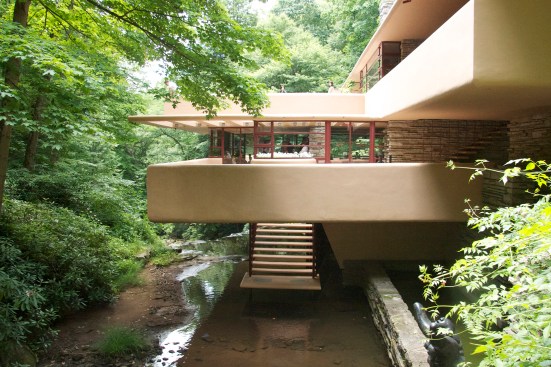
It is this particular confluence of ideas and form that make Fallingwater the most accomplished item in all of Wright’s voluminous catalog. In no other building was he able to express with greater clarity and complexity this notion of an architecture that eschews the piling up of material to create monuments, static objects, and closed-off forms in favor of the fluid weaving of space, material, form, and the life in and around the structure.
There is a reason we keep coming back to Fallingwater. It is Frank Lloyd Wright’s best work and should be a model for how to make architecture today. Let’s stop worrying about building and (re)learn how to weave.
Read more stories about Frank Lloyd Wright.
